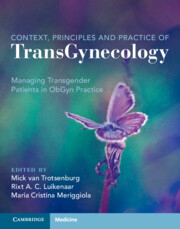Book contents
- Context, Principles, and Practice of Transgynecology
- Context, Principles, and Practice of Transgynecology
- Copyright page
- Dedication
- Contents
- Foreword
- Preface
- Contributors
- Abbreviations
- Section A Contextual Transgynecology
- Section B Practicing Transgynecology
- Section C Gynecological Surgery for Transgender Males
- Chapter 18 Gender-affirming Hysterectomy for Trans Men
- Chapter 19 Opportunistic Salpingectomy in Transgender and Gender Diverse People
- Chapter 20 Colpectomy
- Section D Sexuality and Contraception
- Section E Fertility and Reproduction
- Section F Impact of Gender-affirming Hormonal Therapy on Genital Organs
- Section G Screening and Prophylaxis
- Transgynecology Index
- References
Chapter 18 - Gender-affirming Hysterectomy for Trans Men
from Section C - Gynecological Surgery for Transgender Males
Published online by Cambridge University Press: 22 December 2022
- Context, Principles, and Practice of Transgynecology
- Context, Principles, and Practice of Transgynecology
- Copyright page
- Dedication
- Contents
- Foreword
- Preface
- Contributors
- Abbreviations
- Section A Contextual Transgynecology
- Section B Practicing Transgynecology
- Section C Gynecological Surgery for Transgender Males
- Chapter 18 Gender-affirming Hysterectomy for Trans Men
- Chapter 19 Opportunistic Salpingectomy in Transgender and Gender Diverse People
- Chapter 20 Colpectomy
- Section D Sexuality and Contraception
- Section E Fertility and Reproduction
- Section F Impact of Gender-affirming Hormonal Therapy on Genital Organs
- Section G Screening and Prophylaxis
- Transgynecology Index
- References
Summary
All routes of hysterectomy are feasible and safe when performed for gender affirmation, without documented increased risk of complications. Minimally invasive approaches are most commonly used, each with particular benefits for trans men in terms of scarring, preservation of vaginal epithelium, and conservation of vasculature for future gender-affirming surgeries. Perioperative implications of testosterone use are individualized and should be discussed preoperatively. Hysterectomy can be combined with other gender-affirming surgeries including mastectomy, vaginectomy, metoidioplasty, or phalloplasty with specific benefits noted for concurrent vaginectomy.
- Type
- Chapter
- Information
- Context, Principles and Practice of TransGynecologyManaging Transgender Patients in ObGyn Practice, pp. 139 - 144Publisher: Cambridge University PressPrint publication year: 2022



